Strategic Change Management: Models, Stakeholder Engagement & Strategy
VerifiedAdded on 2023/06/12
|20
|4313
|198
Report
AI Summary
This report provides a comprehensive overview of strategic change management, focusing on the importance of adapting to evolving business dynamics. It examines various strategic change models, including Lewin's change management model, McKinsey 7-S Model, Kotter's Theory, the ADKAR model, Kubler-Ross change curve, and Burke-Litwin’s change management model, evaluating their relevance in the current economy. The report assesses the value of strategic intervention techniques such as team building, contingency theory, human resource management, and techno-structural intervention. It further explores the need for strategic change driven by market dynamics, economic downturns, customer expectations, mission changes, and new technologies. The resource implications of not responding to strategic change are discussed, covering human, physical, and financial resources. The report also details the development of systems to involve stakeholders in planning change, creating change management strategies, and managing resistance to change. Finally, it outlines the development and implementation of an appropriate change model, along with measures to monitor progress, emphasizing the role of effective communication and employee empowerment.
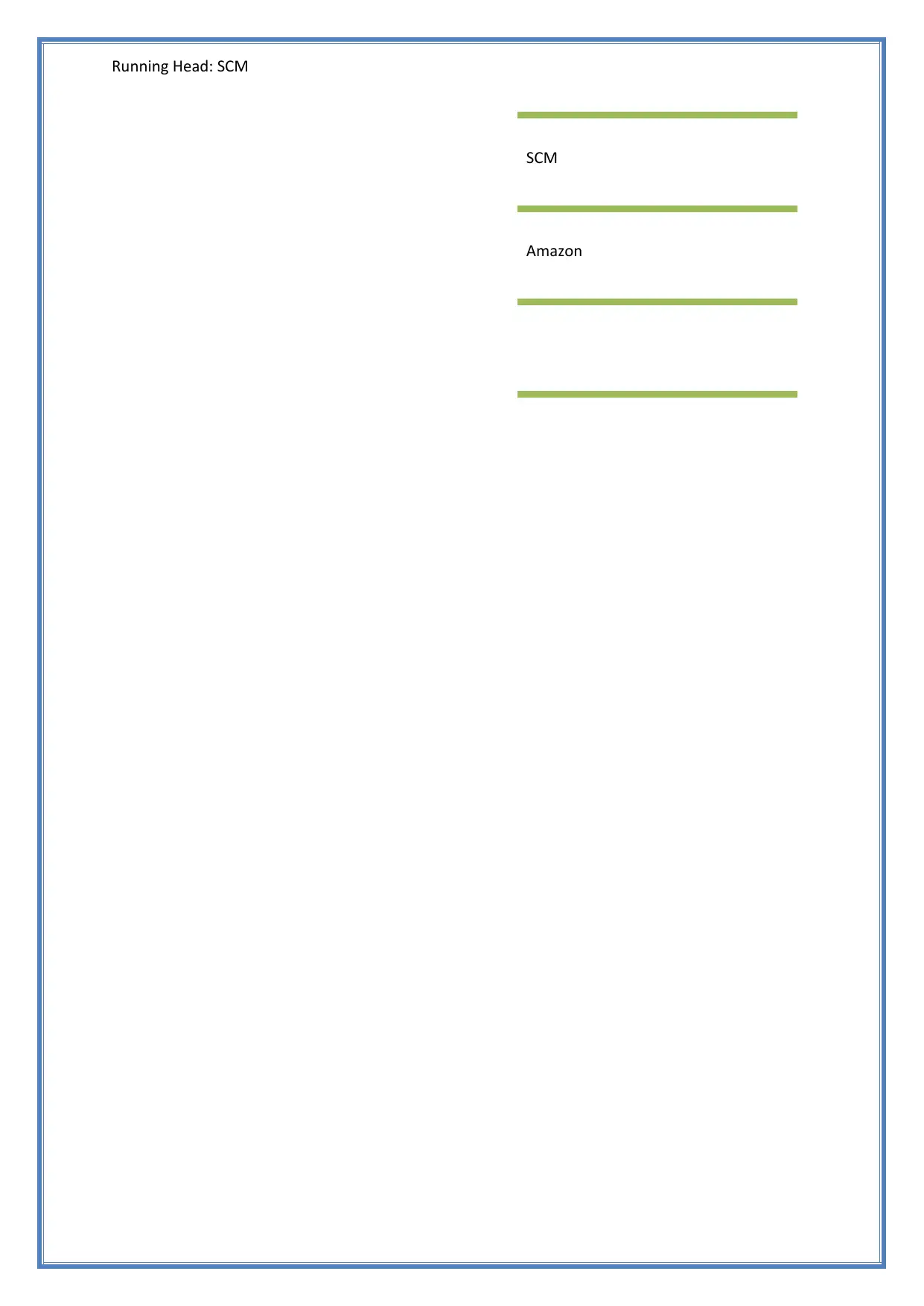
Running Head: SCM
SCM
Amazon
SCM
Amazon
Paraphrase This Document
Need a fresh take? Get an instant paraphrase of this document with our AI Paraphraser

SCM P a g e | 1
Table of Content
Task 1: Understand the Background to organizational change....................................................4
Models of strategic Change...........................................................................................................4
Lewin’s change management model............................................................................................4
McKinsey 7-S Model.......................................................................................................................4
Kotter Theory...................................................................................................................................5
The ADKAR model.........................................................................................................................6
Kubler-Ross change curve............................................................................................................7
Burke-Litwin’s change management model................................................................................7
1.2 Evaluate the relevance of models of strategic change to organization in the current
economy...............................................................................................................................................8
1.3 Assess the value of using strategic intervention techniques in the organization.................8
Team building consensus and conflict.........................................................................................8
Contingency Theory.......................................................................................................................9
Human resource management......................................................................................................9
Techno-structural Intervention......................................................................................................9
Task 2: Understand issues relating to strategic change in the organization...............................9
2.1 Examine the need for strategic change in the Organization...............................................9
Market Dynamics............................................................................................................................9
Economic Downturn.....................................................................................................................10
Customer Expectation..................................................................................................................10
Change in the mission..................................................................................................................10
Table of Content
Task 1: Understand the Background to organizational change....................................................4
Models of strategic Change...........................................................................................................4
Lewin’s change management model............................................................................................4
McKinsey 7-S Model.......................................................................................................................4
Kotter Theory...................................................................................................................................5
The ADKAR model.........................................................................................................................6
Kubler-Ross change curve............................................................................................................7
Burke-Litwin’s change management model................................................................................7
1.2 Evaluate the relevance of models of strategic change to organization in the current
economy...............................................................................................................................................8
1.3 Assess the value of using strategic intervention techniques in the organization.................8
Team building consensus and conflict.........................................................................................8
Contingency Theory.......................................................................................................................9
Human resource management......................................................................................................9
Techno-structural Intervention......................................................................................................9
Task 2: Understand issues relating to strategic change in the organization...............................9
2.1 Examine the need for strategic change in the Organization...............................................9
Market Dynamics............................................................................................................................9
Economic Downturn.....................................................................................................................10
Customer Expectation..................................................................................................................10
Change in the mission..................................................................................................................10
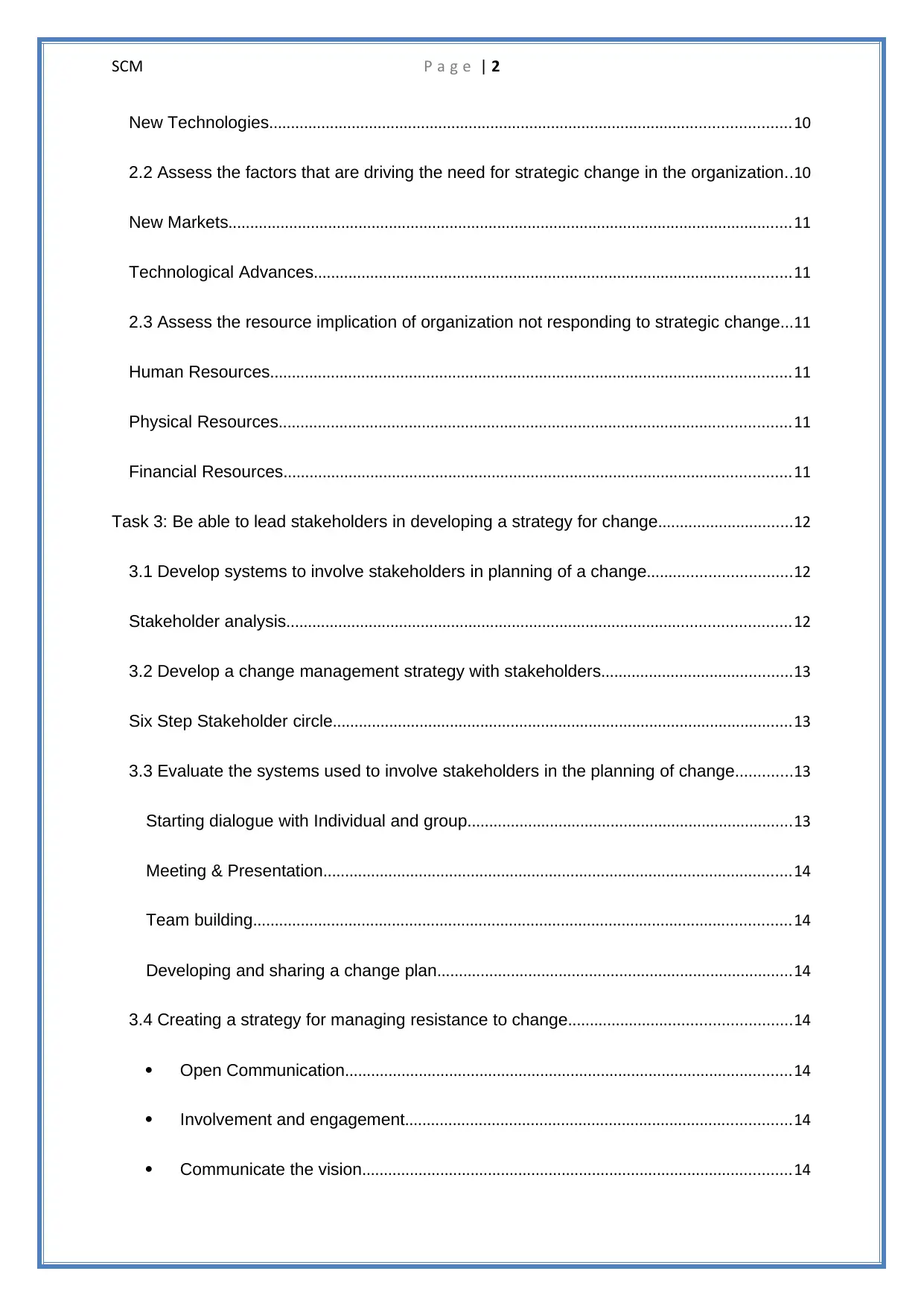
SCM P a g e | 2
New Technologies........................................................................................................................10
2.2 Assess the factors that are driving the need for strategic change in the organization..10
New Markets..................................................................................................................................11
Technological Advances..............................................................................................................11
2.3 Assess the resource implication of organization not responding to strategic change...11
Human Resources........................................................................................................................11
Physical Resources......................................................................................................................11
Financial Resources.....................................................................................................................11
Task 3: Be able to lead stakeholders in developing a strategy for change...............................12
3.1 Develop systems to involve stakeholders in planning of a change.................................12
Stakeholder analysis....................................................................................................................12
3.2 Develop a change management strategy with stakeholders............................................13
Six Step Stakeholder circle..........................................................................................................13
3.3 Evaluate the systems used to involve stakeholders in the planning of change.............13
Starting dialogue with Individual and group...........................................................................13
Meeting & Presentation............................................................................................................14
Team building............................................................................................................................14
Developing and sharing a change plan..................................................................................14
3.4 Creating a strategy for managing resistance to change...................................................14
Open Communication.......................................................................................................14
Involvement and engagement.........................................................................................14
Communicate the vision...................................................................................................14
New Technologies........................................................................................................................10
2.2 Assess the factors that are driving the need for strategic change in the organization..10
New Markets..................................................................................................................................11
Technological Advances..............................................................................................................11
2.3 Assess the resource implication of organization not responding to strategic change...11
Human Resources........................................................................................................................11
Physical Resources......................................................................................................................11
Financial Resources.....................................................................................................................11
Task 3: Be able to lead stakeholders in developing a strategy for change...............................12
3.1 Develop systems to involve stakeholders in planning of a change.................................12
Stakeholder analysis....................................................................................................................12
3.2 Develop a change management strategy with stakeholders............................................13
Six Step Stakeholder circle..........................................................................................................13
3.3 Evaluate the systems used to involve stakeholders in the planning of change.............13
Starting dialogue with Individual and group...........................................................................13
Meeting & Presentation............................................................................................................14
Team building............................................................................................................................14
Developing and sharing a change plan..................................................................................14
3.4 Creating a strategy for managing resistance to change...................................................14
Open Communication.......................................................................................................14
Involvement and engagement.........................................................................................14
Communicate the vision...................................................................................................14
⊘ This is a preview!⊘
Do you want full access?
Subscribe today to unlock all pages.

Trusted by 1+ million students worldwide
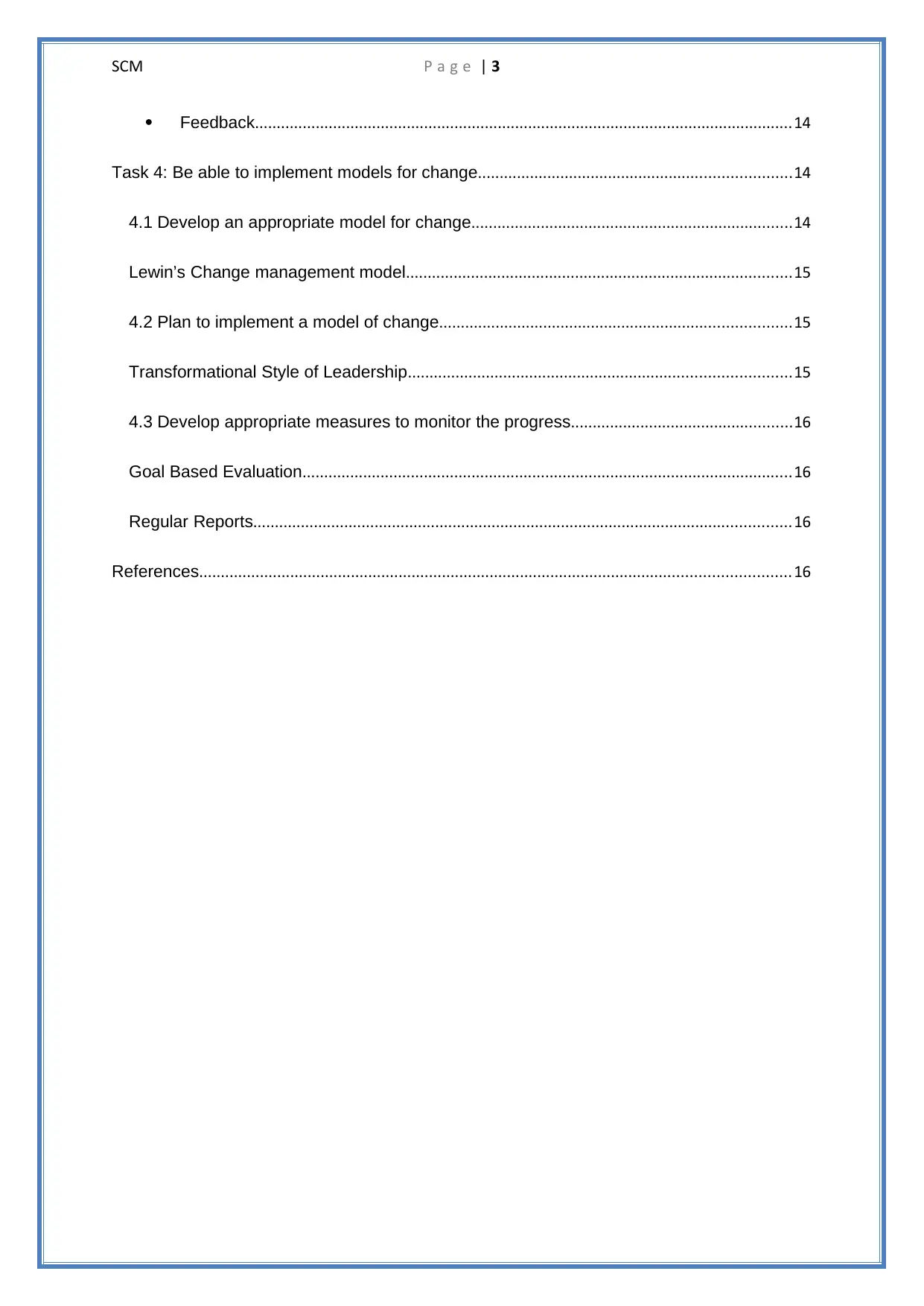
SCM P a g e | 3
Feedback............................................................................................................................14
Task 4: Be able to implement models for change........................................................................14
4.1 Develop an appropriate model for change..........................................................................14
Lewin’s Change management model.........................................................................................15
4.2 Plan to implement a model of change.................................................................................15
Transformational Style of Leadership........................................................................................15
4.3 Develop appropriate measures to monitor the progress...................................................16
Goal Based Evaluation.................................................................................................................16
Regular Reports............................................................................................................................16
References........................................................................................................................................16
Feedback............................................................................................................................14
Task 4: Be able to implement models for change........................................................................14
4.1 Develop an appropriate model for change..........................................................................14
Lewin’s Change management model.........................................................................................15
4.2 Plan to implement a model of change.................................................................................15
Transformational Style of Leadership........................................................................................15
4.3 Develop appropriate measures to monitor the progress...................................................16
Goal Based Evaluation.................................................................................................................16
Regular Reports............................................................................................................................16
References........................................................................................................................................16
Paraphrase This Document
Need a fresh take? Get an instant paraphrase of this document with our AI Paraphraser
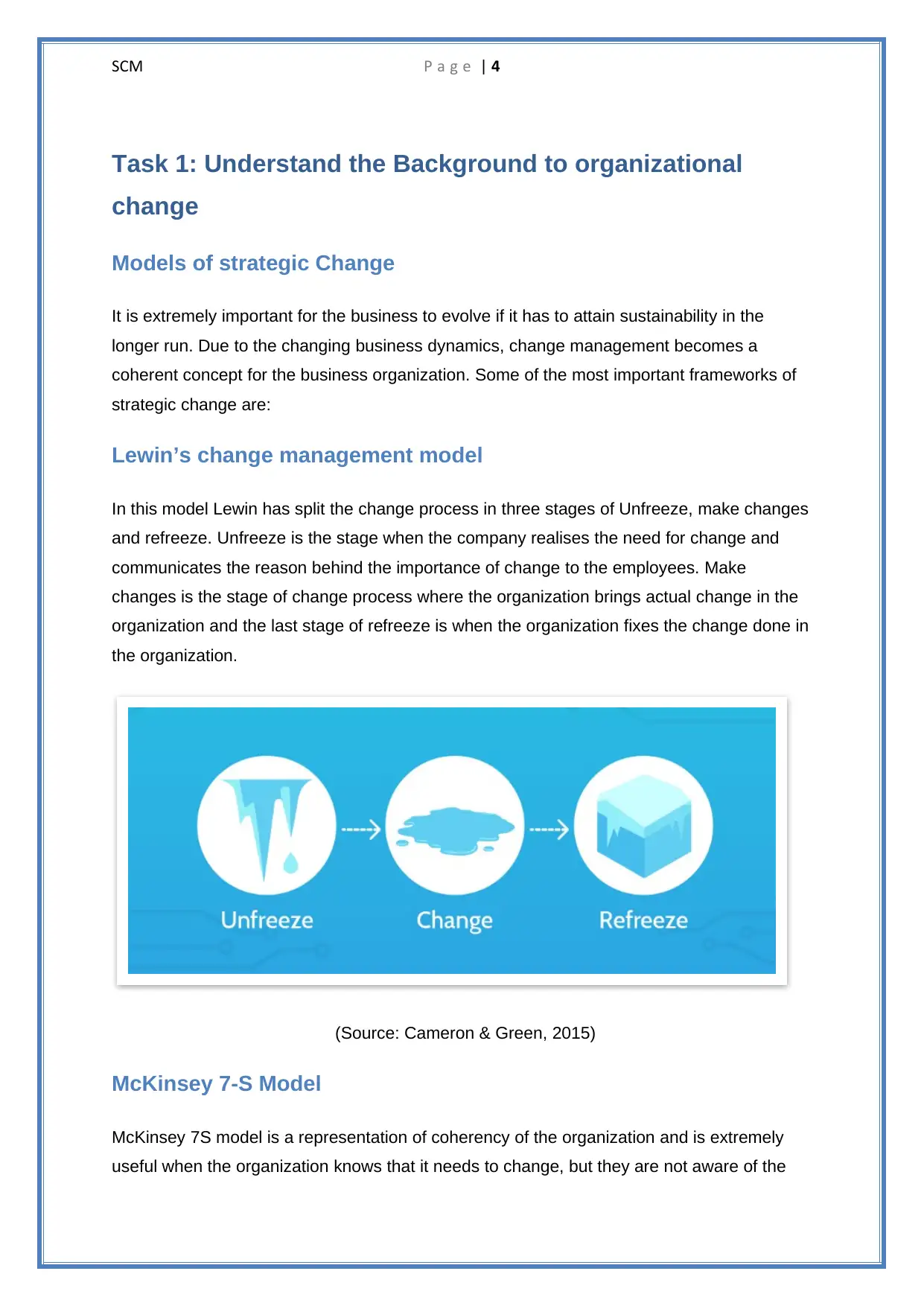
SCM P a g e | 4
Task 1: Understand the Background to organizational
change
Models of strategic Change
It is extremely important for the business to evolve if it has to attain sustainability in the
longer run. Due to the changing business dynamics, change management becomes a
coherent concept for the business organization. Some of the most important frameworks of
strategic change are:
Lewin’s change management model
In this model Lewin has split the change process in three stages of Unfreeze, make changes
and refreeze. Unfreeze is the stage when the company realises the need for change and
communicates the reason behind the importance of change to the employees. Make
changes is the stage of change process where the organization brings actual change in the
organization and the last stage of refreeze is when the organization fixes the change done in
the organization.
(Source: Cameron & Green, 2015)
McKinsey 7-S Model
McKinsey 7S model is a representation of coherency of the organization and is extremely
useful when the organization knows that it needs to change, but they are not aware of the
Task 1: Understand the Background to organizational
change
Models of strategic Change
It is extremely important for the business to evolve if it has to attain sustainability in the
longer run. Due to the changing business dynamics, change management becomes a
coherent concept for the business organization. Some of the most important frameworks of
strategic change are:
Lewin’s change management model
In this model Lewin has split the change process in three stages of Unfreeze, make changes
and refreeze. Unfreeze is the stage when the company realises the need for change and
communicates the reason behind the importance of change to the employees. Make
changes is the stage of change process where the organization brings actual change in the
organization and the last stage of refreeze is when the organization fixes the change done in
the organization.
(Source: Cameron & Green, 2015)
McKinsey 7-S Model
McKinsey 7S model is a representation of coherency of the organization and is extremely
useful when the organization knows that it needs to change, but they are not aware of the
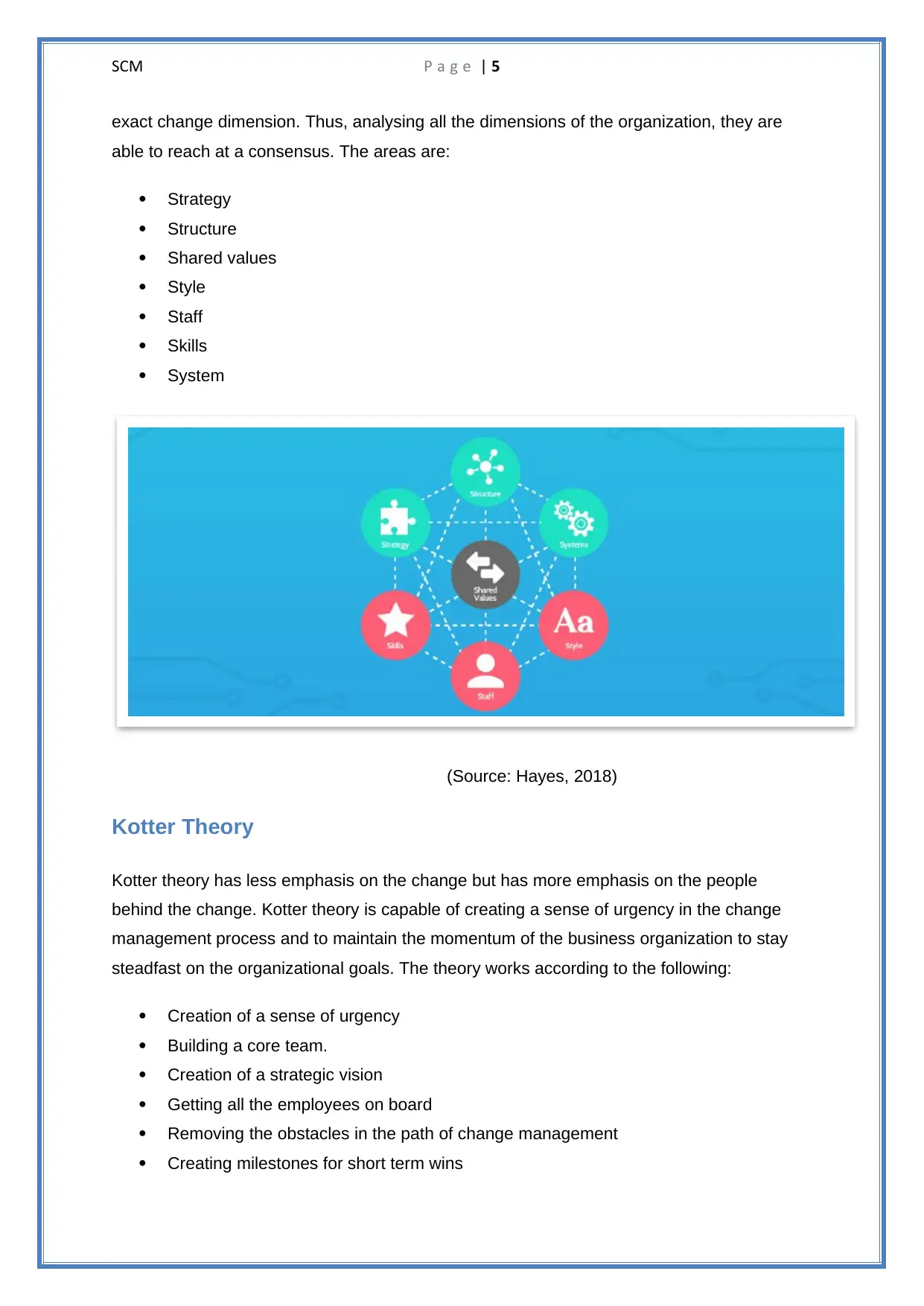
SCM P a g e | 5
exact change dimension. Thus, analysing all the dimensions of the organization, they are
able to reach at a consensus. The areas are:
Strategy
Structure
Shared values
Style
Staff
Skills
System
(Source: Hayes, 2018)
Kotter Theory
Kotter theory has less emphasis on the change but has more emphasis on the people
behind the change. Kotter theory is capable of creating a sense of urgency in the change
management process and to maintain the momentum of the business organization to stay
steadfast on the organizational goals. The theory works according to the following:
Creation of a sense of urgency
Building a core team.
Creation of a strategic vision
Getting all the employees on board
Removing the obstacles in the path of change management
Creating milestones for short term wins
exact change dimension. Thus, analysing all the dimensions of the organization, they are
able to reach at a consensus. The areas are:
Strategy
Structure
Shared values
Style
Staff
Skills
System
(Source: Hayes, 2018)
Kotter Theory
Kotter theory has less emphasis on the change but has more emphasis on the people
behind the change. Kotter theory is capable of creating a sense of urgency in the change
management process and to maintain the momentum of the business organization to stay
steadfast on the organizational goals. The theory works according to the following:
Creation of a sense of urgency
Building a core team.
Creation of a strategic vision
Getting all the employees on board
Removing the obstacles in the path of change management
Creating milestones for short term wins
⊘ This is a preview!⊘
Do you want full access?
Subscribe today to unlock all pages.

Trusted by 1+ million students worldwide

SCM P a g e | 6
Sustained acceleration
Setting the changes in the root of the organization.
(Source: Doppelt, 2017)
The ADKAR model
ADKAR change model was created by Jeffery Hiatt, and in totality is a bottom up method of
change management, like Kotter’s model, this model is also focussed on the individuals
responsible for the change process. The model is more focussed on a set of goals to reach,
which can be seen in the reflection of the acronym name of the model. The model stands for:
Awareness (The inherent need for change)
Desire ( This is to participate and support the change)
Knowledge ( This is related to how to change in the business organization)
Ability ( This is to implement the required skills and behaviours)
Reinforcement ( This is to sustain the change)
Sustained acceleration
Setting the changes in the root of the organization.
(Source: Doppelt, 2017)
The ADKAR model
ADKAR change model was created by Jeffery Hiatt, and in totality is a bottom up method of
change management, like Kotter’s model, this model is also focussed on the individuals
responsible for the change process. The model is more focussed on a set of goals to reach,
which can be seen in the reflection of the acronym name of the model. The model stands for:
Awareness (The inherent need for change)
Desire ( This is to participate and support the change)
Knowledge ( This is related to how to change in the business organization)
Ability ( This is to implement the required skills and behaviours)
Reinforcement ( This is to sustain the change)
Paraphrase This Document
Need a fresh take? Get an instant paraphrase of this document with our AI Paraphraser

SCM P a g e | 7
(Source: Hornstein, 2015)
Kubler-Ross change curve
The model is also called as the model of five stages of grief and is based on those five
stages which fulfil a specific niche in the domain of change management. The model is
focussed on to deal with the emotional response of the people who are affected by the
change. The five stages of emotional responses are:
Denial
Anger
Bargaining
Depression
Acceptance
(Source: Goetsch & Davis, 2014)
Burke-Litwin’s change management model
This model primarily revolves around establishing a cause and effect relationship between
the 12 dimensions of the organization which is key to its change. This model aims to bring
the change in the performance of the entire team by linking the performance of the team with
the possible internal and external factors which might affect the performance. The 12
dimensions are categorized as follows:
Organization culture External Environment
(Source: Hornstein, 2015)
Kubler-Ross change curve
The model is also called as the model of five stages of grief and is based on those five
stages which fulfil a specific niche in the domain of change management. The model is
focussed on to deal with the emotional response of the people who are affected by the
change. The five stages of emotional responses are:
Denial
Anger
Bargaining
Depression
Acceptance
(Source: Goetsch & Davis, 2014)
Burke-Litwin’s change management model
This model primarily revolves around establishing a cause and effect relationship between
the 12 dimensions of the organization which is key to its change. This model aims to bring
the change in the performance of the entire team by linking the performance of the team with
the possible internal and external factors which might affect the performance. The 12
dimensions are categorized as follows:
Organization culture External Environment
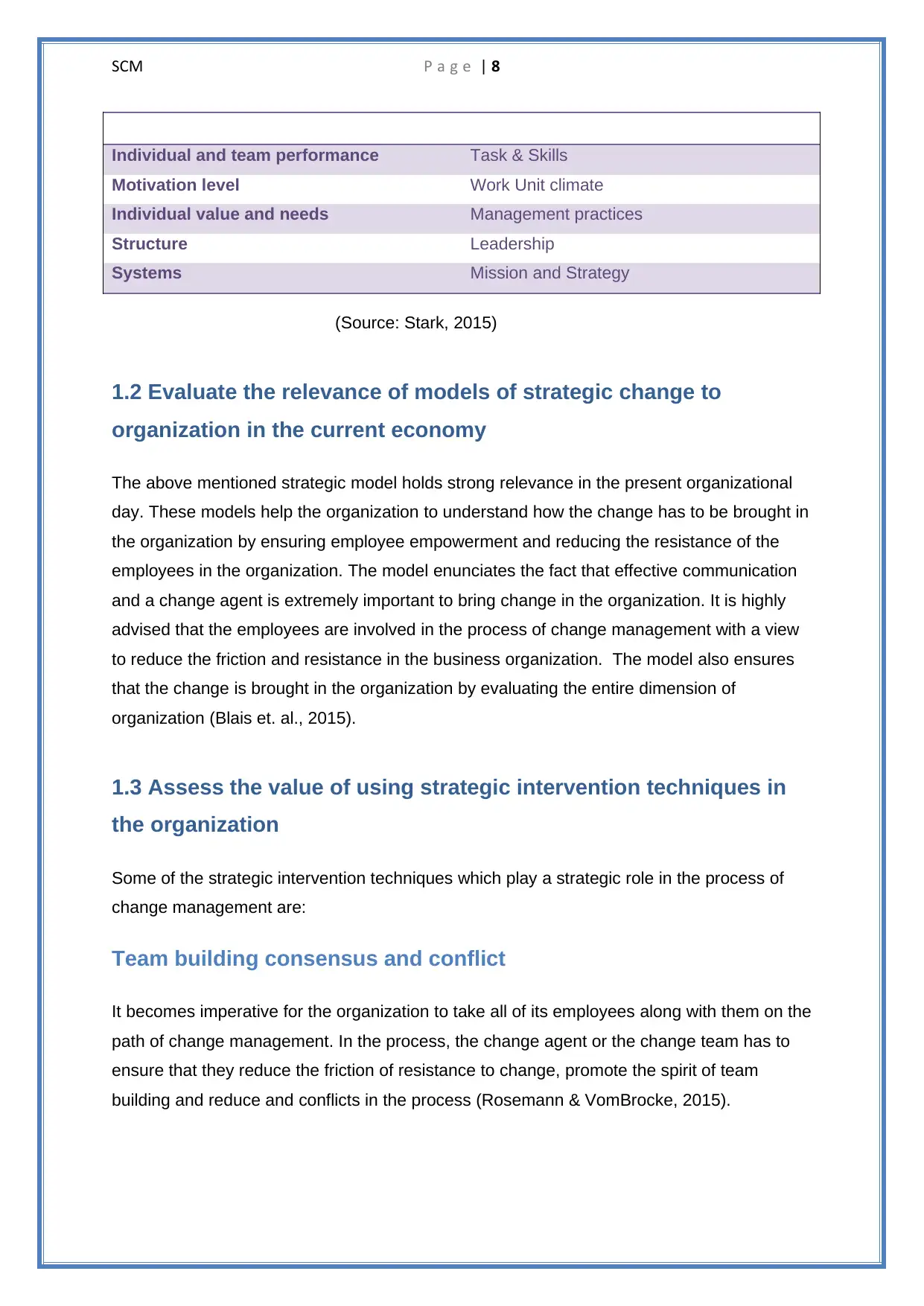
SCM P a g e | 8
Individual and team performance Task & Skills
Motivation level Work Unit climate
Individual value and needs Management practices
Structure Leadership
Systems Mission and Strategy
(Source: Stark, 2015)
1.2 Evaluate the relevance of models of strategic change to
organization in the current economy
The above mentioned strategic model holds strong relevance in the present organizational
day. These models help the organization to understand how the change has to be brought in
the organization by ensuring employee empowerment and reducing the resistance of the
employees in the organization. The model enunciates the fact that effective communication
and a change agent is extremely important to bring change in the organization. It is highly
advised that the employees are involved in the process of change management with a view
to reduce the friction and resistance in the business organization. The model also ensures
that the change is brought in the organization by evaluating the entire dimension of
organization (Blais et. al., 2015).
1.3 Assess the value of using strategic intervention techniques in
the organization
Some of the strategic intervention techniques which play a strategic role in the process of
change management are:
Team building consensus and conflict
It becomes imperative for the organization to take all of its employees along with them on the
path of change management. In the process, the change agent or the change team has to
ensure that they reduce the friction of resistance to change, promote the spirit of team
building and reduce and conflicts in the process (Rosemann & VomBrocke, 2015).
Individual and team performance Task & Skills
Motivation level Work Unit climate
Individual value and needs Management practices
Structure Leadership
Systems Mission and Strategy
(Source: Stark, 2015)
1.2 Evaluate the relevance of models of strategic change to
organization in the current economy
The above mentioned strategic model holds strong relevance in the present organizational
day. These models help the organization to understand how the change has to be brought in
the organization by ensuring employee empowerment and reducing the resistance of the
employees in the organization. The model enunciates the fact that effective communication
and a change agent is extremely important to bring change in the organization. It is highly
advised that the employees are involved in the process of change management with a view
to reduce the friction and resistance in the business organization. The model also ensures
that the change is brought in the organization by evaluating the entire dimension of
organization (Blais et. al., 2015).
1.3 Assess the value of using strategic intervention techniques in
the organization
Some of the strategic intervention techniques which play a strategic role in the process of
change management are:
Team building consensus and conflict
It becomes imperative for the organization to take all of its employees along with them on the
path of change management. In the process, the change agent or the change team has to
ensure that they reduce the friction of resistance to change, promote the spirit of team
building and reduce and conflicts in the process (Rosemann & VomBrocke, 2015).
⊘ This is a preview!⊘
Do you want full access?
Subscribe today to unlock all pages.

Trusted by 1+ million students worldwide
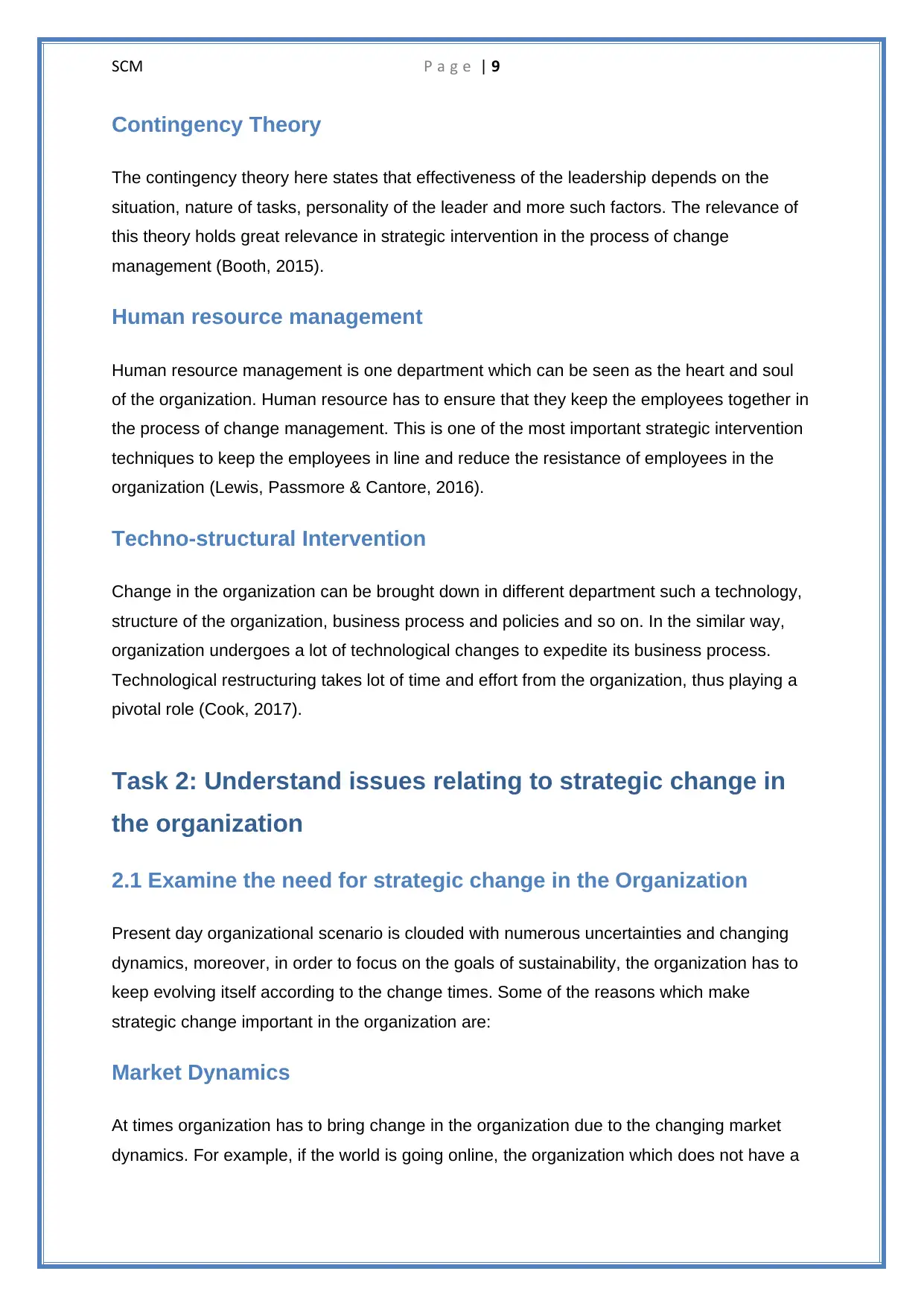
SCM P a g e | 9
Contingency Theory
The contingency theory here states that effectiveness of the leadership depends on the
situation, nature of tasks, personality of the leader and more such factors. The relevance of
this theory holds great relevance in strategic intervention in the process of change
management (Booth, 2015).
Human resource management
Human resource management is one department which can be seen as the heart and soul
of the organization. Human resource has to ensure that they keep the employees together in
the process of change management. This is one of the most important strategic intervention
techniques to keep the employees in line and reduce the resistance of employees in the
organization (Lewis, Passmore & Cantore, 2016).
Techno-structural Intervention
Change in the organization can be brought down in different department such a technology,
structure of the organization, business process and policies and so on. In the similar way,
organization undergoes a lot of technological changes to expedite its business process.
Technological restructuring takes lot of time and effort from the organization, thus playing a
pivotal role (Cook, 2017).
Task 2: Understand issues relating to strategic change in
the organization
2.1 Examine the need for strategic change in the Organization
Present day organizational scenario is clouded with numerous uncertainties and changing
dynamics, moreover, in order to focus on the goals of sustainability, the organization has to
keep evolving itself according to the change times. Some of the reasons which make
strategic change important in the organization are:
Market Dynamics
At times organization has to bring change in the organization due to the changing market
dynamics. For example, if the world is going online, the organization which does not have a
Contingency Theory
The contingency theory here states that effectiveness of the leadership depends on the
situation, nature of tasks, personality of the leader and more such factors. The relevance of
this theory holds great relevance in strategic intervention in the process of change
management (Booth, 2015).
Human resource management
Human resource management is one department which can be seen as the heart and soul
of the organization. Human resource has to ensure that they keep the employees together in
the process of change management. This is one of the most important strategic intervention
techniques to keep the employees in line and reduce the resistance of employees in the
organization (Lewis, Passmore & Cantore, 2016).
Techno-structural Intervention
Change in the organization can be brought down in different department such a technology,
structure of the organization, business process and policies and so on. In the similar way,
organization undergoes a lot of technological changes to expedite its business process.
Technological restructuring takes lot of time and effort from the organization, thus playing a
pivotal role (Cook, 2017).
Task 2: Understand issues relating to strategic change in
the organization
2.1 Examine the need for strategic change in the Organization
Present day organizational scenario is clouded with numerous uncertainties and changing
dynamics, moreover, in order to focus on the goals of sustainability, the organization has to
keep evolving itself according to the change times. Some of the reasons which make
strategic change important in the organization are:
Market Dynamics
At times organization has to bring change in the organization due to the changing market
dynamics. For example, if the world is going online, the organization which does not have a
Paraphrase This Document
Need a fresh take? Get an instant paraphrase of this document with our AI Paraphraser
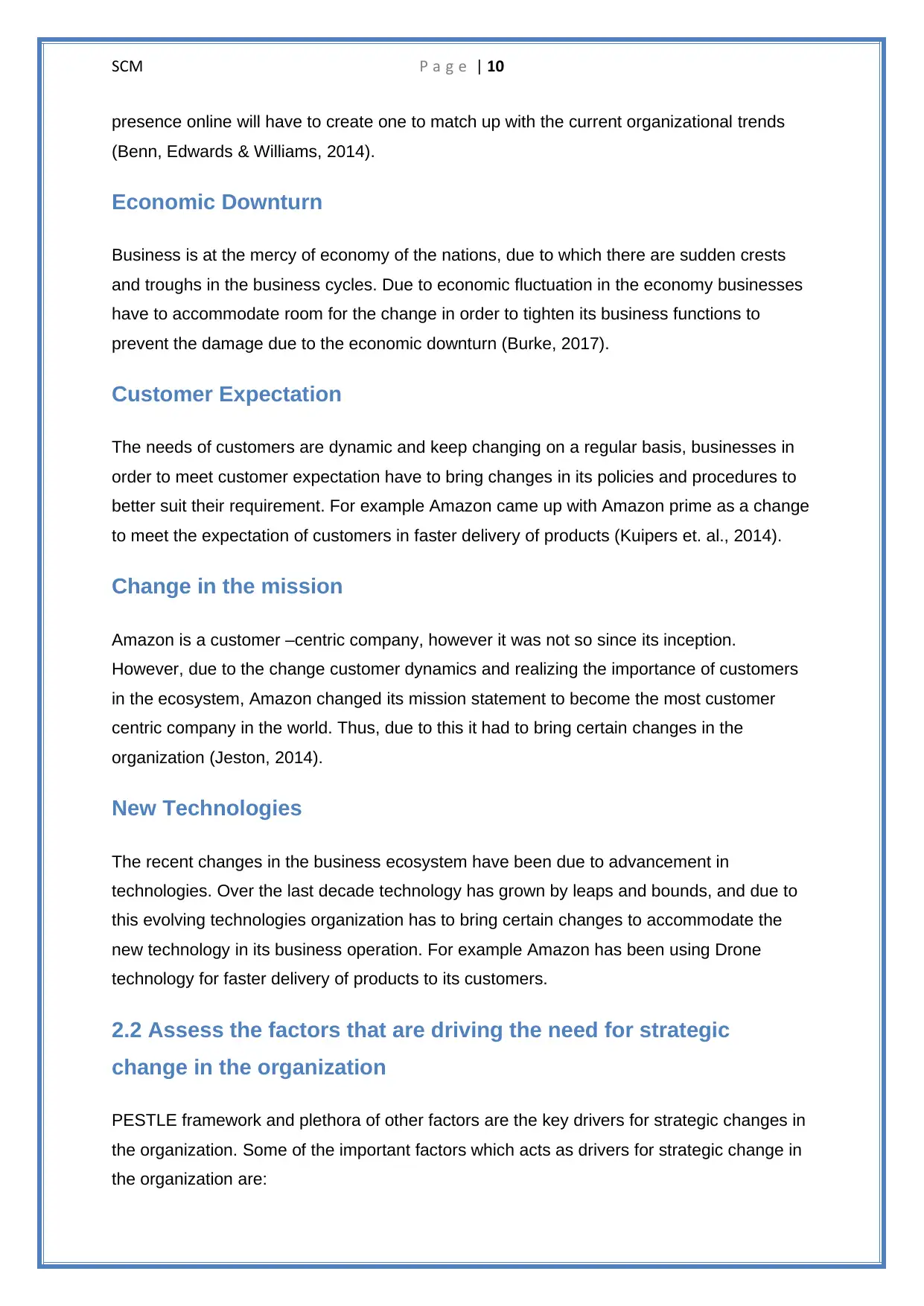
SCM P a g e | 10
presence online will have to create one to match up with the current organizational trends
(Benn, Edwards & Williams, 2014).
Economic Downturn
Business is at the mercy of economy of the nations, due to which there are sudden crests
and troughs in the business cycles. Due to economic fluctuation in the economy businesses
have to accommodate room for the change in order to tighten its business functions to
prevent the damage due to the economic downturn (Burke, 2017).
Customer Expectation
The needs of customers are dynamic and keep changing on a regular basis, businesses in
order to meet customer expectation have to bring changes in its policies and procedures to
better suit their requirement. For example Amazon came up with Amazon prime as a change
to meet the expectation of customers in faster delivery of products (Kuipers et. al., 2014).
Change in the mission
Amazon is a customer –centric company, however it was not so since its inception.
However, due to the change customer dynamics and realizing the importance of customers
in the ecosystem, Amazon changed its mission statement to become the most customer
centric company in the world. Thus, due to this it had to bring certain changes in the
organization (Jeston, 2014).
New Technologies
The recent changes in the business ecosystem have been due to advancement in
technologies. Over the last decade technology has grown by leaps and bounds, and due to
this evolving technologies organization has to bring certain changes to accommodate the
new technology in its business operation. For example Amazon has been using Drone
technology for faster delivery of products to its customers.
2.2 Assess the factors that are driving the need for strategic
change in the organization
PESTLE framework and plethora of other factors are the key drivers for strategic changes in
the organization. Some of the important factors which acts as drivers for strategic change in
the organization are:
presence online will have to create one to match up with the current organizational trends
(Benn, Edwards & Williams, 2014).
Economic Downturn
Business is at the mercy of economy of the nations, due to which there are sudden crests
and troughs in the business cycles. Due to economic fluctuation in the economy businesses
have to accommodate room for the change in order to tighten its business functions to
prevent the damage due to the economic downturn (Burke, 2017).
Customer Expectation
The needs of customers are dynamic and keep changing on a regular basis, businesses in
order to meet customer expectation have to bring changes in its policies and procedures to
better suit their requirement. For example Amazon came up with Amazon prime as a change
to meet the expectation of customers in faster delivery of products (Kuipers et. al., 2014).
Change in the mission
Amazon is a customer –centric company, however it was not so since its inception.
However, due to the change customer dynamics and realizing the importance of customers
in the ecosystem, Amazon changed its mission statement to become the most customer
centric company in the world. Thus, due to this it had to bring certain changes in the
organization (Jeston, 2014).
New Technologies
The recent changes in the business ecosystem have been due to advancement in
technologies. Over the last decade technology has grown by leaps and bounds, and due to
this evolving technologies organization has to bring certain changes to accommodate the
new technology in its business operation. For example Amazon has been using Drone
technology for faster delivery of products to its customers.
2.2 Assess the factors that are driving the need for strategic
change in the organization
PESTLE framework and plethora of other factors are the key drivers for strategic changes in
the organization. Some of the important factors which acts as drivers for strategic change in
the organization are:
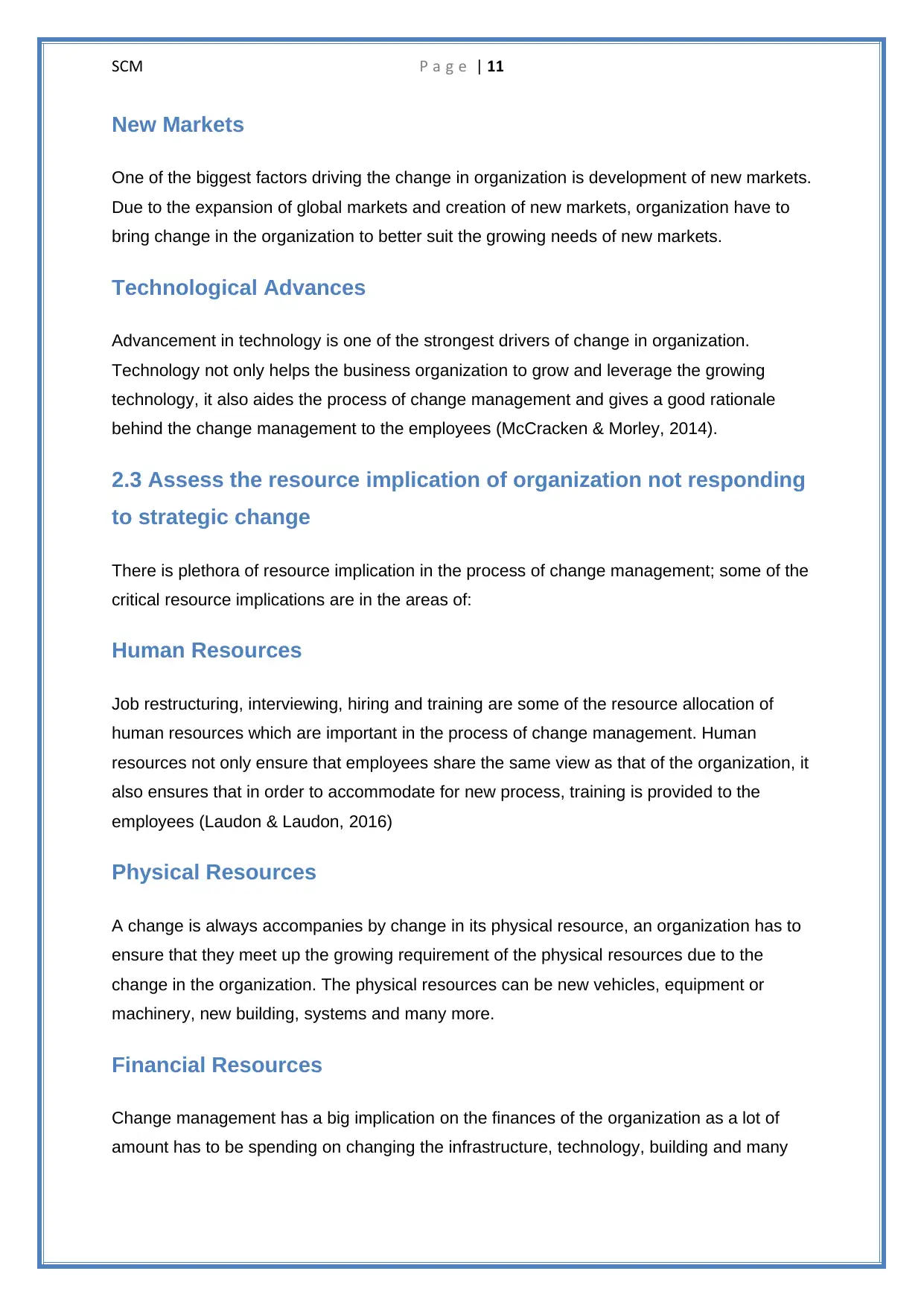
SCM P a g e | 11
New Markets
One of the biggest factors driving the change in organization is development of new markets.
Due to the expansion of global markets and creation of new markets, organization have to
bring change in the organization to better suit the growing needs of new markets.
Technological Advances
Advancement in technology is one of the strongest drivers of change in organization.
Technology not only helps the business organization to grow and leverage the growing
technology, it also aides the process of change management and gives a good rationale
behind the change management to the employees (McCracken & Morley, 2014).
2.3 Assess the resource implication of organization not responding
to strategic change
There is plethora of resource implication in the process of change management; some of the
critical resource implications are in the areas of:
Human Resources
Job restructuring, interviewing, hiring and training are some of the resource allocation of
human resources which are important in the process of change management. Human
resources not only ensure that employees share the same view as that of the organization, it
also ensures that in order to accommodate for new process, training is provided to the
employees (Laudon & Laudon, 2016)
Physical Resources
A change is always accompanies by change in its physical resource, an organization has to
ensure that they meet up the growing requirement of the physical resources due to the
change in the organization. The physical resources can be new vehicles, equipment or
machinery, new building, systems and many more.
Financial Resources
Change management has a big implication on the finances of the organization as a lot of
amount has to be spending on changing the infrastructure, technology, building and many
New Markets
One of the biggest factors driving the change in organization is development of new markets.
Due to the expansion of global markets and creation of new markets, organization have to
bring change in the organization to better suit the growing needs of new markets.
Technological Advances
Advancement in technology is one of the strongest drivers of change in organization.
Technology not only helps the business organization to grow and leverage the growing
technology, it also aides the process of change management and gives a good rationale
behind the change management to the employees (McCracken & Morley, 2014).
2.3 Assess the resource implication of organization not responding
to strategic change
There is plethora of resource implication in the process of change management; some of the
critical resource implications are in the areas of:
Human Resources
Job restructuring, interviewing, hiring and training are some of the resource allocation of
human resources which are important in the process of change management. Human
resources not only ensure that employees share the same view as that of the organization, it
also ensures that in order to accommodate for new process, training is provided to the
employees (Laudon & Laudon, 2016)
Physical Resources
A change is always accompanies by change in its physical resource, an organization has to
ensure that they meet up the growing requirement of the physical resources due to the
change in the organization. The physical resources can be new vehicles, equipment or
machinery, new building, systems and many more.
Financial Resources
Change management has a big implication on the finances of the organization as a lot of
amount has to be spending on changing the infrastructure, technology, building and many
⊘ This is a preview!⊘
Do you want full access?
Subscribe today to unlock all pages.

Trusted by 1+ million students worldwide
1 out of 20
Related Documents
Your All-in-One AI-Powered Toolkit for Academic Success.
+13062052269
info@desklib.com
Available 24*7 on WhatsApp / Email
![[object Object]](/_next/static/media/star-bottom.7253800d.svg)
Unlock your academic potential
Copyright © 2020–2025 A2Z Services. All Rights Reserved. Developed and managed by ZUCOL.




